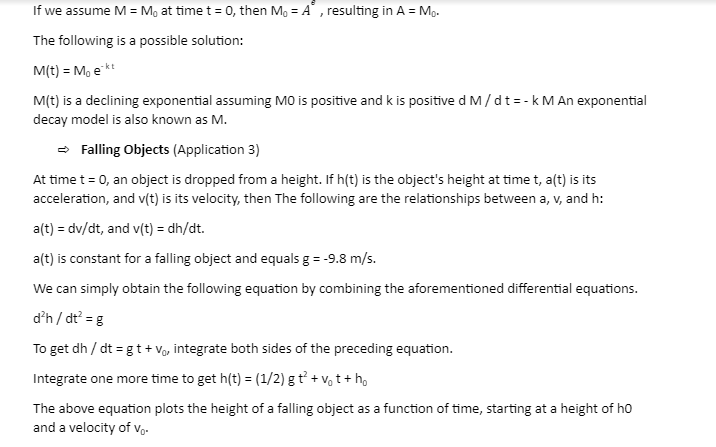The derivative of at least one unknown function, either an ordinary or partial derivative, is present in a differential equation. If the rate of change of a function y with respect to x is inversely proportional to y, we write dy/dx = k/y.
A differential equation in calculus is an equation in which the derivative (derivatives) of the dependent variable with respect to the independent variable are involved (variables). The derivative is also known as a rate of change, and the differential equation helps us visualise a relationship between a changing variable and a change in another quantity. Z=g(x) is the given function if y is a dependent variable, f is an unknown function, and x is an independent variable.
- Differential Equations Applications
Ordinary differential equations are used in real life to calculate the movement or flow of electricity, the motion of a moving item, such as a pendulum, and to demonstrate thermodynamic concepts. They’re also used to visualizes the course of diseases in graphical form in medical terminology. Differential equations are commonly employed to describe mathematical concepts like population growth or radioactive decay. Exponential Growth – Population (Application 1)
Let P(t) be a quantity that grows with time t and whose rate of growth is proportional to the same quantity P as follows: dP / dt = kP
P’s first derivative is dp / dt, k > 0, and t is the time.

Exponential Decay – Radioactive Material (Application 2)
Let M(t) be the amount of a product that declines over time t, with the rate of reduction proportional to dM / dt = – kM
The first derivative of M is dM / dt, k > 0, and t is the time.
M(t) = A-ekt is obtained by solving the above first order differential equation.
A is a non-zero constant.

Newton’s Law of Cooling (Application 4)
It’s a mathematical model that depicts how an object’s temperature changes in a particular environment. The difference between the temperature T of the item and the temperature Te of the environment surrounding the object is proportional to the rate of change (in time) of the temperature, according to the law.

Conclusion:
In the actual world, ordinary differential equations are used to compute the movement of electricity, the movement of a pendulum, and to illustrate thermodynamics ideas. Another prominent application in medical language is graphic representations of illness progression.
Differential equations are commonly employed to describe mathematical concepts like population growth or radioactive decay. The Law of Cooling by Newton. When a hot object is placed in a cool area, it radiates heat to the environment, lowering its temperature. The rate at which an object’s temperature declines is proportional to the difference between the object’s temperature and the ambient temperature, according to Newton’s Law of Cooling. The difference between these temperatures is largest during the start of the colling process, hence this is when the rate of temperature decline is greatest.
 Profile
Profile Settings
Settings Refer your friends
Refer your friends Sign out
Sign out






